Greetings, book-eaters and treat-lovers!
When I started this newsletter, I immediately knew that each year would be its own volume, and each issue would have a number. It seemed obvious to me, but now I realize this isn’t the way most newsletters are labeled. It comes from my background in zine-making. I used to run a farm with a CSA, and each week, along with their vegetables, members would get a handmade CSA news zine filled with recipes, games, poems, farm news, and other tidbits. It was a lot of work, and I still miss making it.
Here’s a scan of one of those old CSA zines. This one is drawn by my friend Cheryl, who used to run the farm with me. Yes, she drew Beet Seeger, and yes, you can buy your very own Beet Seeger t-shirt, along with many other veggie celebrities, at her Etsy Shop, Rutabaga Bodega.
Anyway, books! In the spirit of ditching rigidity, my first regular newsletter of 2022 isn’t regular at all. I spent the first few weeks of January reading a whole bunch of short books, all under 200 pages. It was an energizing way to start the year! So instead of three book reviews on a theme, today I bring you eight mini reviews of short books.
The Books
Moonstone by Sjón, translated from the Icelandic by Victoria Cribb
This odd and dreamlike novel takes place in Reykjavik during the 1918 flu pandemic. It’s set over the course of a few month, beginning when the flu first arrives in Iceland. It follows the wanderings of a queer teenager, Máni, a sex worker and cinema lover. He lives with an elderly woman relation, and spends most of his time going to the movies. He is completely enraptured with cinema, and much of the book is him talking about it: the directors he likes, the films he like, the schedules of the two theaters in Reykjavik.
It’s a weird, twisty little novel. At one point Máni gets the flu, and the narrative sinks into his fever dreams and hallucinations. This happens more than once. The book moves from dream to reality to hallucination to fantasy, and it’s not always clear which is which. I loved this about it. Máni, who feels alone in the world, who cannot live safely as himself, retreats often into imagined worlds. For him, cinema, and by extension the stories he creates in his own head, is not just entertainment; it’s how he survives. It’s hard to keep track of the narrative if you’re not paying close attention.
But there’s also a lot of straightforward and practical details about life during the pandemic. Máni muses about which theaters have closed, and which haven’t. After her recovers, he begins helping out at the local hospital, and there are also lot of details about that: the people he cares for, all the death, the gruesome question of what to do with the bodies. There are community meetings, and people angry with the government response, and eerie descriptions of a city gone silent. It all feels incredibly familiar. That hyper-reality paired with the dreaminess of the writing makes for a fascinating, though sometimes dizzying, read.
Two Old Women by Velma Wallis
This is a lovely, quiet, fable-like story about two old women from the Gwich’in band of Athabaskan Alaskan people. Wallis learned the story, passed down through generations, from her mother, and she writes it down with a light touch and beautiful simplicity.
During a rough winter, The People decide to leave two old women behind to die, believing that they won’t be able to keep up and will put everyone’s survival in danger. But Sa’ and Ch’idzigyaak refuse to give up. They work together to survive the brutal northern winter, finding inner strength they’d both forgotten they had. The story is about the tasks they preform to stay alive—setting rabbit snares, drying fish, building shelter—and also about how their friendship, and their abandonment, changes them. When The People learn the old women didn’t die—well, it’s a fable, and you can guess the kinds of lessons it teaches them.
One thing I’ve been striving for in my reading life recently is to keep myself open to different kinds of stories. I’m less interested in my own preconceived ideas about what a book should be, and more interested in the essence of a story. Why is it in the world? What’s it doing? This book reads like the legend it is, and I thoroughly enjoyed it even though it’s not exactly in my wheelhouse.
Las Biuty Queens by Iván Monalisa Ojeda, translated from the Spanish by Hannah Kauders
This collection of stories is a witness and a love letter. It’s about a group of queer and trans characters living in New York City, mostly sex workers, mostly trans women, mostly undocumented Latine immigrants. Each story captures a moment, many of them ordinary: two friends getting high, a trip to the ER, a funeral, a night at a bar. There’s a lot of dialogue. Several of the stories are mostly conversations, friends and lovers talking about their work, their breakups, their livers. Their money problems. The people they know—who’s doing well, who’s moved away, who’s in trouble, who’s died. It’s a mix of sorrow and gossip, lighthearted banter and deep pain. Ojeda doesn’t sugarcoat or sentimentalize. He/she just writes down the the messy truths of these characters’ lives.
Most of the stories are narrated by the same character, a Chilean trans woman named Monalisa. She tells a lot of stories about her friends; they read like elegies and celebrations, a bearing witness to the details of lives that are too often ignored. I loved the interconnected of it. It’s the sort of collection I wouldn’t have liked, or had the patience to read, a few years ago. Not much happens. The characters don’t change. I would have complained about the lack of tension, the lack of relentless forward momentum toward something. But I am coming to love this kind of book. The quiet documentation of moments. The beautifully rendered details of ordinary life. The rich descriptions of a city, a conversation, a morning walk, a panic attack—just for their own sake. There’s also a lovely thread of hope and connection and sisterhood running through the whole book. Despite the often harrowing subject matter, you get the sense that Ojeda isn’t taking herself/himself too seriously. There’s a lot of humor in it.
I feel safe. I walk across the icy bridge back to the Bronx, accompanied by the strength of my Mexican friend. And the strength of so many others who know what it means to cross from one side to the other, what it means to get home in one piece, full of memories and without a trace of bitterness.
The Black Emerald by Jeanne Thornton
I bought this book because I absolutely loved Thornton’s most recent novel, Summer Fun. If you’re into Weird Queer, I cannot recommend it enough. These stories are bizarre. WTF bizarre. Half the time I wasn’t exactly sure what I was reading. And yet Thornton’s prose is so assured that it didn’t really matter.
In the titular novella, Regan, a teenager desperate to get back together with her ex-girlfriend, is haunted by the ghost of a reclusive and disturbing cartoon artist. He lurks inside her drawings, transforming them into upsetting images that tell truths she doesn’t necessarily want to look at. In another story, a woman’s boyfriend moves into the walls and begins communicating with her through the bedroom mirror. My favorite story is about a college student who wasn’t allowed to sit on the furniture as a child. It twists and meanders and seems to wander off in random directions, and then crystallizes at the end.
There’s an air of desperation in all of these stories. Character are not quite themselves, not quite who they say they are or who they want to be. They hold back pieces of themselves. I didn’t trust them, as narrators. At one point in The Black Emerald, Regan’s ex-girlfriend describes a drawing Regan did of her as “kind of in the world, but not of the world.” That’s the feeling so many of these stories describe: trying to stay grounded in the world, and slipping.
Neotenica by Joon Oluchi Lee
This is a novel told in a series of linked vignettes about a Korean American couple: Young Ae, a ballet dancer who’s now a PhD student, and her unnamed husband, who seeks out casual sex with men. It’s set in San Francisco, and much of it involves these two characters moving around the city. Young Ae’s husband has a series of hookups; Young Ae has an affair. They walk their dogs, go grocery shopping, flirt at the laundromat, have a kid. Sometimes another character becomes central; there are sections told from the POVs of various people both Young Ae and Young Ae’s husband have sex with, their friends, seemingly random people they interact with and then never see again.
What I love most about this book is its slipperiness. Young Ae and her husband do not have a traditional heteronormative relationship, but it’s not really a queer relationship, either. They don’t label it, or themselves. Neither of them spend much time analyzing their own actions or motivations; they just act. There’s a refreshing looseness to the way they both move about the world.
Hot, Wet & Shaking by Kaleigh Trace
I do not want to be quietly disabled, trying to fit in and absorb myself into an able-body-centric world. Just as I do not want to be quietly sexual, pretending I do not do that thing that so many of us do (or at least think about doing). I fuck, and I love, and I move through this world as a woman with a disability.
I absolutely loved this book of personal essays about sex, disability, gender, queerness, and how we talk about sex. Trace is a queer disabled sex educator, and she shares her own journey of sexual discovery alongside an examination of the ableist, queerphobic, racist, and patriarchal systems that tell us sex should look (feel, be) a certain way.
It’s not comprehensive or academic or even all that analytical. It’s fun and celebratory, informal, silly, impassioned. Trace writes about talking with customers in the sex shop where she works; learning to give herself an orgasm; learning to love her disabled body; awkward and messy sexual encounters; getting an abortion; the language she uses to talk about sex, and a whole lot more. I love her expansive definition of fucking as any act that leads to erotic pleasure, as well as her acknowledgment that “fucking” isn’t a word that will resonate with everyone.
Mostly I love how fierce and unapologetic and direct this book is. It’s a celebration of bodes and desire and all the weird, messy, wonderful, challenging ways we share our bodies with each other (or not). It’s an invitation for all of us whose sexual experiences/lives/desires don’t fit into the sad, small, narrow framework that heteropatriarchy makes—to be loud, joyful, creative, free. To take up space.
The labels queer and disabled fit well together and I am honored to hold them both. They fit together because they both involve resistance. Resistance against those tired ideas of what and how one should be, resistance against presumed and ill-fitting “truths” about the world.
Uncomfortable Labels by Laura Kate Dale
This is a thoughtful, informative, linear, and somewhat dry memoir about Dale's life as a gay trans autistic woman. Dry isn't a criticism here—I mean it simply as an observation about her writing style: clear and observant, nothing flowery (though there is humor!) It’s very journalistic, almost as if she’s reporting on her own life. She shares a lot of facts, but those facts are important: how she experiences sound and texture, what she likes about certain kinds of clothes, how it feels to join a roller derby team. There's a ton of heart, feeling, and vulnerability in the facts. Dale just lays out her thoughts, feelings and experiences, sentence after sentence. It makes for a quick read, one I was totally engrossed in. I read memoirs because I want to hear someone's story in their own voice, and I loved getting to hear Dale's story the way she chose to tell it.
A Year Without a Name by Cyrus Dunham
Dunham begins their memoir with this line: “I could try to tell a story that ends with resolution, but the only way to succeed would be to lie.”
This made me immediately trust them because it soon becomes clear that this is a memoir told from the middle. It is extremely earnest, almost unbearably so at times. There’s no humor, no space, none of the reflection that comes from looking back on something that’s already happened. It’s full of painful self-examination and self-analysis. Dunham is trying to figure out who they are within its pages, trying to see themself clearly. Sometimes it reads like a conversation they’re having with themself. The writing is sharp, often beautiful, almost performative, although performative in a way that felt authentic to me. As if the performance is the only way to get through the experience and uncover the truth.
It’s a memoir about gender and bodies and self-discovery and finding the words, courage, space for invention and reinvention, formation and transformation. It’s not a linear trans narrative. It’s a messy, circular one. Dunham documents their shifting understanding of their gender, and that understanding goes on shifting. As promised, it doesn’t resolve. This book won’t be for everyone; I can imagine some readers rolling their eyes at it, calling it pretentious. And it is, a bit. But I loved Dunham’s hard edges and self-absorption, their relentless seriousness, their obsession with turning over the same moments again and again and again. Sometimes that’s what it feels like to be in something. And they never pretend this book is anything other than a record of being in it.
The Bake
Apparently I’ve never shared a yeasted bread recipe here, and I can’t have that, so I’m kicking off this year with these delicious, briochey burger buns I made over the weekend. They’re buttery and airy and rich but not too rich. Like all bread, they take time. But the actual mixing and shaping only takes 20 minutes or so!
Spelt & Sesame Burger Buns
This recipe is slightly altered from Smitten Kitchen. I mostly messed around with the ratios of different kinds of flour, because that’s what I do.
Ingredients:
3 Tbs warm milk
2 tsp active dry yeast
2 Tbs honey
2 eggs
50 grams (1/3 cup) all-purpose flour
150 grams (1 1/4 cups) spelt flour
300 grams (2 1/2 cups) bread flour
1 1/2 tsp salt
2 1/2 Tbs (35 grams) unsalted butter, at room temperature
sesame seeds for sprinkling
Combine 1 cup of warm water, the milk, yeast, and honey in a glass measuring cup. Mix and set aside until foamy, about 5 minutes.
In a large bowl, combine the flours and salt. Add the butter with your fingers, breaking it up to form crumbs. Pour in the yeast mixture, along with one beaten egg. Mix with your hands or a wooden spoon until a shaggy dough forms. Dump the dough onto a floured surface and knead for 5-10 minutes, until you have a smooth, elastic dough. It’s quite wet, and that’s okay! You can use a dough scraper to help you unstick it from the counter.
Form the dough into a ball and return it to the bowl. Cover with a dishcloth and let it rise until doubled, 1-2 hours.
Line a tray with parchment paper or a silicone baking mat. Divide the dough into eight equal pieces. Form each piece into a ball, rolling it gently between your palms. Arrange them on the tray, cover with a dishcloth, and let rise until doubled, 1-2 hours.
Preheat the oven to 400 and set a shallow pan of water on the bottom rack. Beat the remaining egg with a bit of water, and brush the tops of the buns. Sprinkle with sesame seeds. Bake for 15-18 minutes, rotating the pan once, until the tops are golden brown and the bottoms sound hollow when tapped. Let cool, and then devour with the burger/sandwich filling/spread of your choice.
The Bowl and The Beat
The Bowl: Pork & Chorizo Burgers with Picked Onions
You didn’t think I’d leave you hanging without a burger recipe, did you? This recipe is based on one from Melissa Clark’s Dinner, but mine are more like large meatball patties than proper burgers, with all the extra stuff I like to throw in. They’re delicious, and they freeze well.
First, if you’re feeling fancy, make pickled onions: thinly slice an onion and dump it in a bowl with a hefty pinch of salt, a few spoonfuls of honey, and a several glugs of red wine vinegar. Mix well and set aside. Next, make the burgers. Put a pound of ground pork and a pound of ground chorizo into a large bowl. Add an egg, a good handful of breadcrumbs, a handful of chopped parsley, a handful of crumbled feta, a few pressed garlic cloves, a teaspoon smoked paprika, a few sprinkles of Aleppo pepper, a teaspoon cumin seeds, and some salt. Chop up a handful of the pickled onions and add those. Gently mix it all together and and form into patties. Place on a baking sheet and broil for 6-10 minutes, depending on the size of your patties. Yum.
The Beat: Home Is Not a Country by Safia Elhillo, read by the author
I just finished this quiet, beautiful novel in verse about lives not lived and the ghosts of alternate possibilities. Nima is a Sudanese American teenager who’s always felt haunted by who she might have been if her mother hadn’t immigrated to America, if she had been born with the name her parents intended to give her: Yasmeen. It’s such a simple idea—who we might have been if something had gone differently—but Elhillo explores it with such exquisite care and grace. The poems are gorgeous, lyrical and soft and full of anger and sadness and tenderness and joy. Elhillo’s narration is the same. It’s a short, impactful book. I loved every moment of it.
The Bookshelf
The Visual
I’ve been hard at work on the Books & Bakes Review Index and I am pumped about it! Here’s a sneak peak of what it looks like—full of lots of useful info, and hopefully very user-friendly. It’ll go out to paid subscribers later this week, along with an index of all the audiobooks I’ve reviewed here. If you want to get in on it, you can subscribe here.
Queer That Book!
You know me—always trying something new! Looking for a readalike for a beloved book, but queer? Or a book with a specific theme? Or a book that will give you the same feeling as one you fell in love with as a teenager, but gayer? You get the idea. My favorite thing about being a Book Person is helping queer books find the readers who need them. Send me your bookish requests, and I’ll share my recommendations here.
Around the Internet
I wrote quite a bit in the last month! On Book Riot: I made a list of must-read queer found family books. I wrote all about one of my very favorite kinds of books: the messay! I rambled for a while about under-the-radar queer books from 2021 and why we need to talk about them. And about characters who I think would make great superheroes! And if you’re longing for a queer comic with the same vibes as your favorite queer book, I’ve got you covered.
For Audiofile, I wrote about three audiobooks I love that celebrate friendship. I reviewed Neel Patel’s Tell Me How to Be for BookPage (and also wrote about it here).
Now Out
Hooray! I Came All This Way to Meet You by Jami Attenberg is now out. I adore this smart, funny, practical, passionate memoir.
The Boost
Every January brings a flood of Most Anticipated booklists. Here are the four that I have bookmarked:
The Most Anticipated LGBTQ+ Books of 2022: This roundup from Electric Lit is the shortest (and therefore most manageable!) one here.
62 Books to Read By Women of Color to Read in 2022: R.O. Kwon’s annual list for Electric Lit is one of my yearly favorites. It’s mostly realistic fiction, with some nonfiction and speculative stuff thrown in. It’s worth looking back over her old lists if you’re looking for a TBR explosion!
80 Queer and Feminist Books Coming Out Winter 2022: Casey is rad and I always look forward to the quarterly lists she puts together for Autostraddle. This one has a great mix of everything, with an emphasis on YA, SFF, and romance.
50 Highly Anticipated Books 2022: Charlott Schönwetter (half_book_and_co) is one of my favorite Bookstagrammers. She reads a lot of interesting nonfiction, small press books, African lit, queer books, and books and translation. There are ton of books on this list I’ve never heard of!
As always, a little bit of beauty to send you on your way: It finally snowed for real. We got about 10” at my house and Nessa and I had two delightful frolics. I am content.
And that’s it until next week. Catch you then!

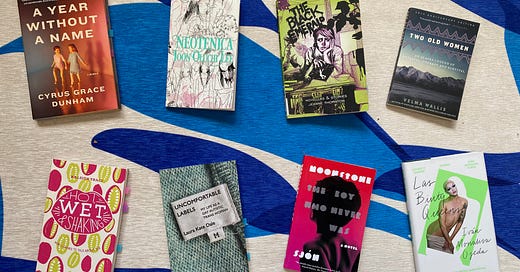




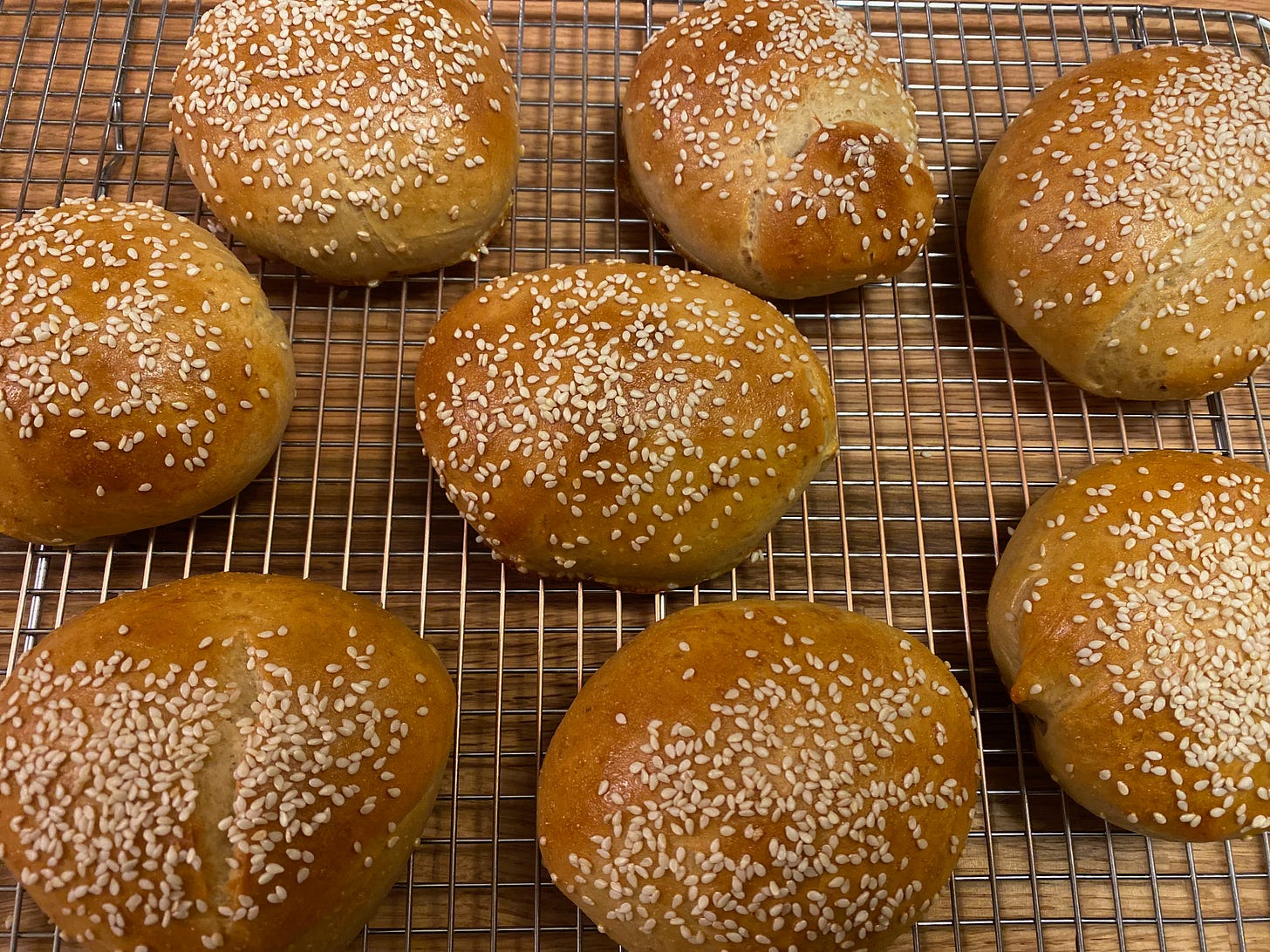
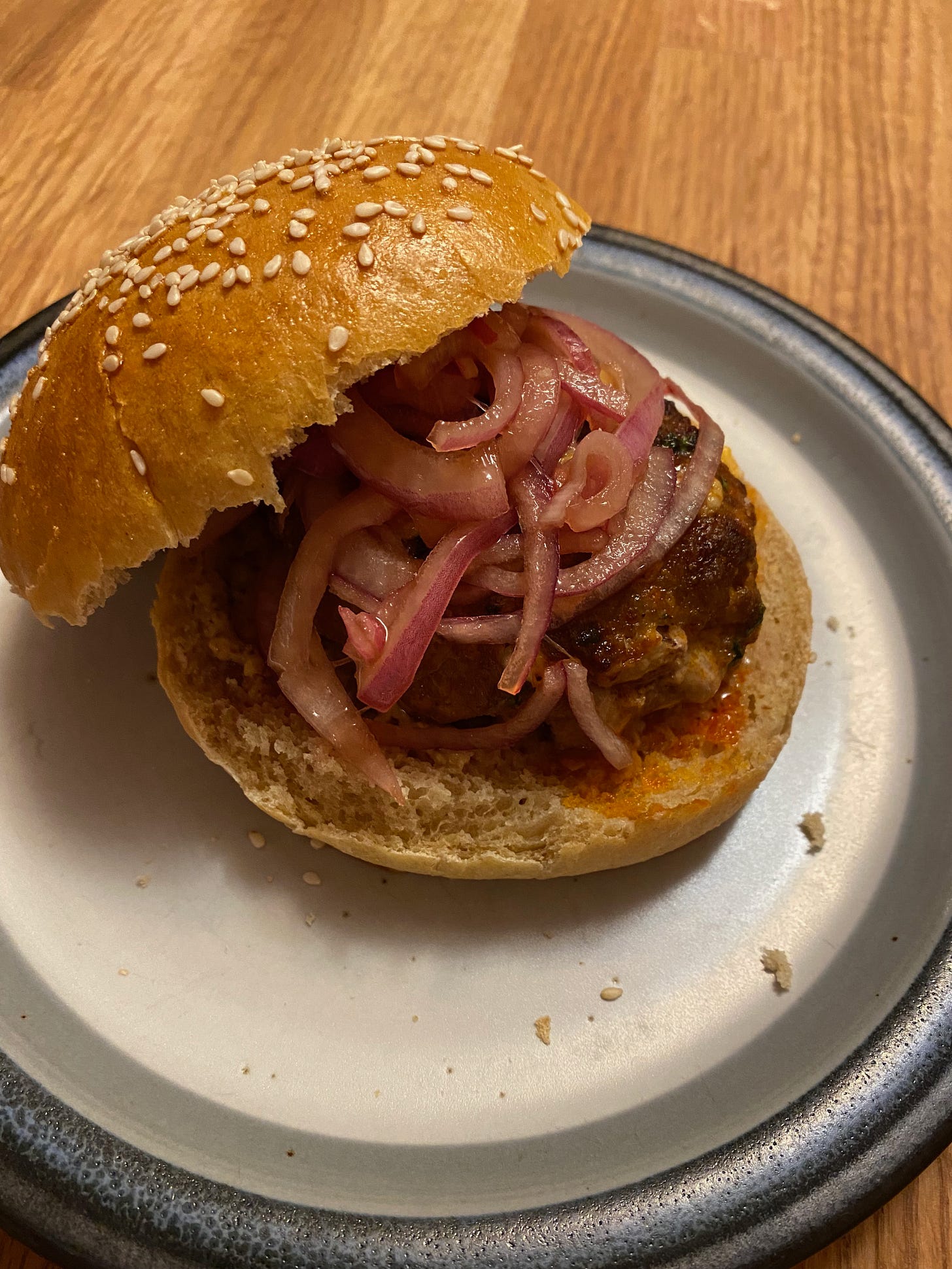
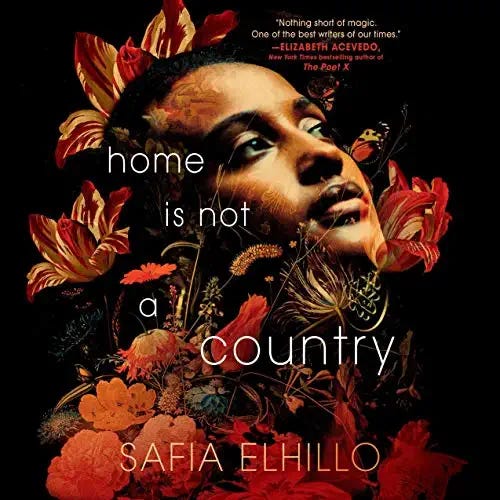

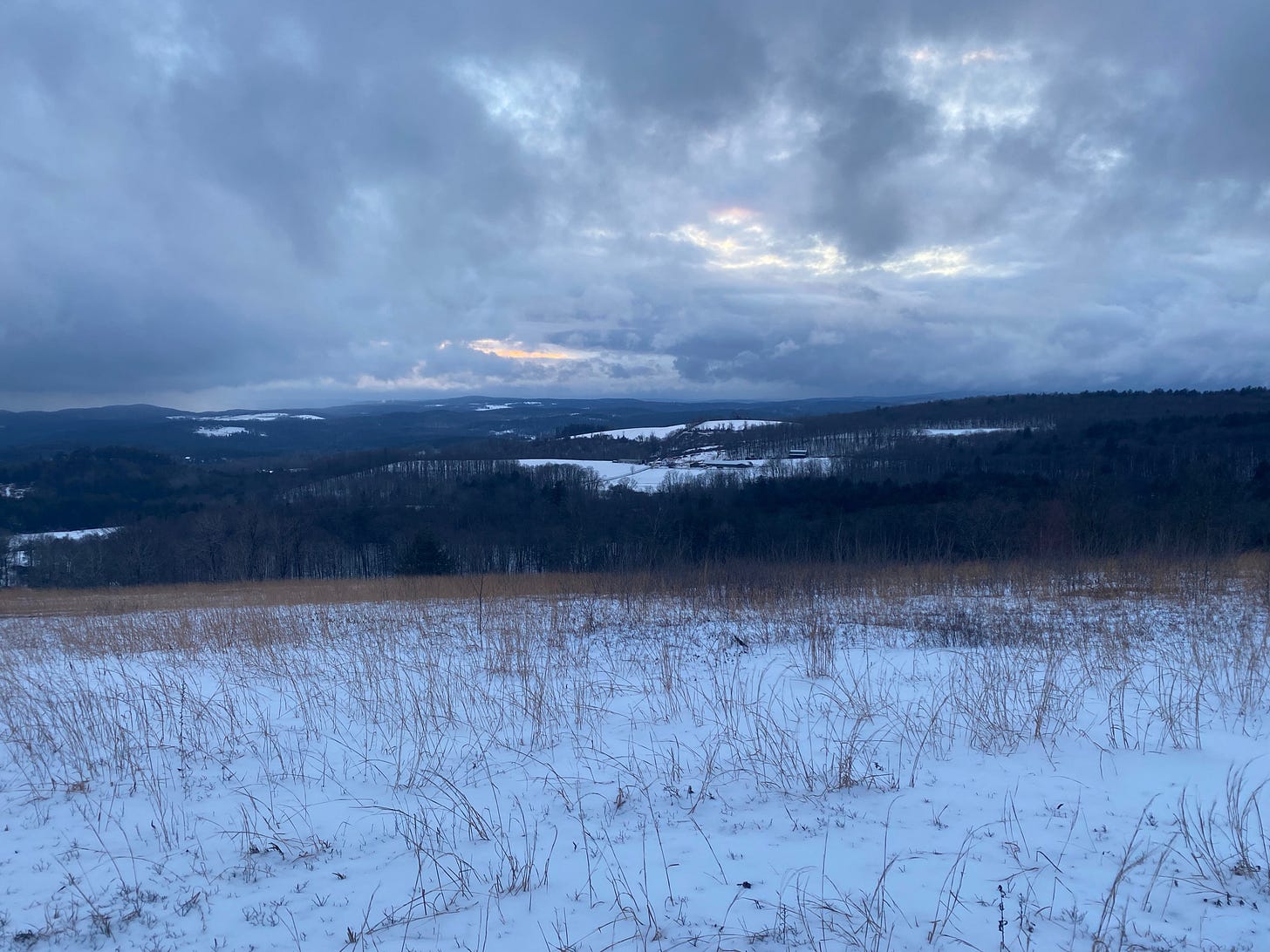
WOW. Laura, there is so much in this issue (my first!) I cannot believe you used to produce a zine with your CSA -- I'm super loyal to our CSA and have been with the farm for years but a zine would tempt me to join another... And your Review Index is an amazing idea. Kudos all around!